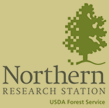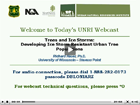Urban Forests – Effects – Water Quality
Effects of Urban Forests on Water Quality
UNRI scientists, working as part of the National Science Foundation’s Baltimore Ecosystem Study (BES) Long-Term Ecological Research Program (LTER), are using the watershed approach to evaluate integrated ecosystem functions of urban watersheds. The LTER research is centered on the Gwynns Falls watershed, a 17,150 ha catchment that traverses a gradient from the urban core of Baltimore, through older urban residential (1900 – 1950) and suburban (1950- 1980) zones, rapidly suburbanizing areas and a rural/suburban fringe.
Long-term sampling network includes four longitudinal sampling sites along the Gwynns Falls as well as four small (40 – 100 ha) watersheds located within or near to the Gwynns Falls. The longitudinal sites provide data on water and nutrient fluxes in the different land use zones of the watershed (rural/suburban, rapidly suburbanizing, old suburban, urban core) and the small watersheds provide more focused data on specific land use areas (forest, agriculture, rural/suburban, urban).
The effects of land use/land cover patterns, hydrologic flowpath structure and dynamics and the presence and distribution of BMPs are evaluated relative to the behavior of the set of sampled catchments. The set of catchments along the urban-rural gradient are compared within our network and with other catchments in the LTER network.
Please visit the Baltimore Ecosystem Study (BES) Long-Term Ecological Research Program (LTER) website , for information on the scope of water quality reserach that is currently being undertaken by the members of the UNRI research team and their cooperating partners.


